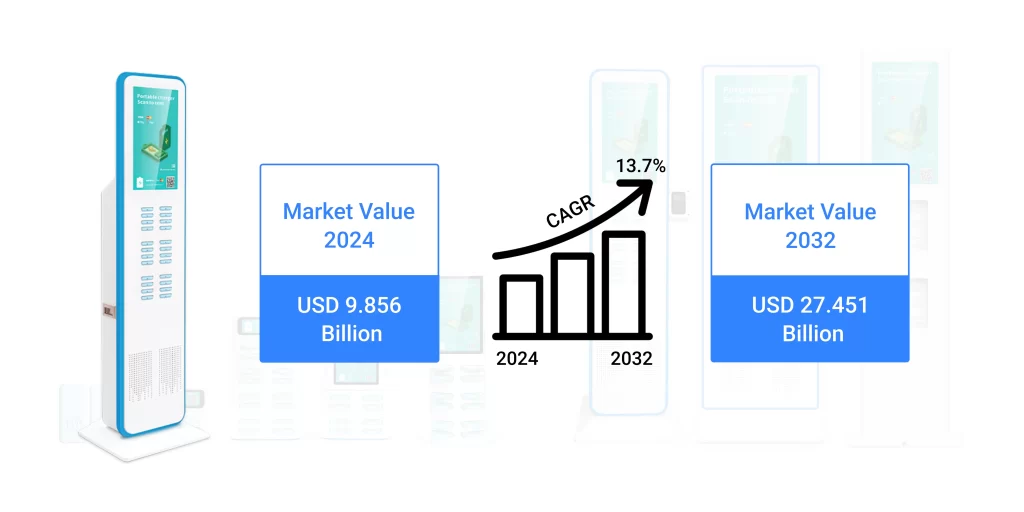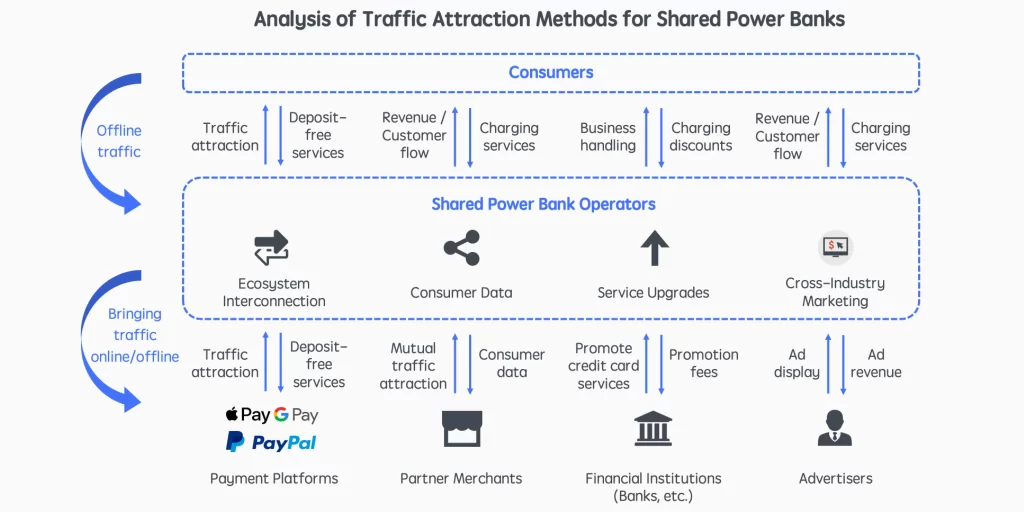The global shared power bank market is growing rapidly, with China leading the way and North America and Europe catching up. As the industry expands, businesses are exploring key strategies to stay competitive—ranging from strategic partnerships and supply chain optimization to new revenue models. This article provides a comprehensive overview of the market landscape, major players, and proven strategies that can help businesses succeed in this evolving industry.
Table of Contents
Part 1. Global Market Overview

The shared power bank industry has been experiencing rapid growth, with increasing demand worldwide. According to a report by Consegic Business Intelligence, the global market size is projected to grow from USD 9.856 billion in 2024 to USD 27.451 billion by 2032. In 2025 alone, the market is expected to reach USD 11.026 billion, maintaining a compound annual growth rate (CAGR) of 13.70% over the coming years.
China remains at the core of the global shared power bank market, holding the largest market share. Meanwhile, North America and Europe are among the fastest-growing markets, indicating increasing consumer acceptance of shared charging solutions and presenting new business opportunities for companies looking to expand.
Part 2. Competitor Analysis
The competitive landscape of the global shared power bank market is becoming increasingly intense, with major brands adopting different strategies to attract users and gain market share. Below are some key players and their core competitive advantages:
2.1 ChargedUp (UK)
Market Strengths:
- User experience-focused business model, with an intuitive mobile app that simplifies the rental and return process.
- Strong presence in high-footfall locations such as cafes, train stations, and entertainment venues.
- Sustainable operations, utilizing renewable energy sources to charge power banks.
- Subscription-based rental options, appealing to frequent users who prefer a hassle-free, cost-effective solution.
Key Takeaways:
ChargedUp differentiates itself by prioritizing sustainability and user convenience. Its digital-first approach and eco-friendly practices align with the growing consumer demand for green energy solutions.
2.2 Powerqube (US)
Market Strengths:
- Focuses on safety and compliance, ensuring its products meet stringent U.S. safety standards, reducing fire hazards and ensuring device longevity.
- Emphasizes sustainability by integrating recyclable battery materials and energy-efficient charging systems.
- Partnerships with hospitality businesses, allowing hotels and restaurants to offer Powerqube stations as a premium service to customers.
- Data-driven approach, leveraging usage analytics to optimize station placements and rental pricing.
Key Takeaways:
Powerqube’s success stems from its strong safety standards and sustainability focus, positioning it as a trusted brand in the U.S. market where consumer concerns around product reliability and environmental impact are high.
2.3 Naki Power (Europe)
Market Strengths:
- Offers one of the most flexible return policies, allowing users to rent in one city and return in another, enhancing convenience for frequent travelers.
- Extensive coverage across European markets, with operations in major cities such as Paris, Berlin, and Madrid.
- Strategic collaborations with event organizers, providing temporary rental stations at concerts, festivals, and sporting events.
- High-end power banks featuring fast-charging capabilities, catering to users who need quick recharges.
Key Takeaways:
Naki Power’s success is built on convenience and flexibility, making it a preferred choice for urban professionals and travelers. Its event-based model also allows for targeted marketing and brand exposure.
These competitive advantages highlight the importance of localization, innovation, and customer-centric services in capturing market share. For businesses looking to enter or expand in this industry, understanding these diverse strategies can provide valuable insights into crafting a sustainable and competitive market approach.
Part 3. Competitive Strategies
China’s shared power bank industry has developed into a highly sophisticated ecosystem, providing valuable insights for businesses looking to dominate global markets. Several key strategies have emerged from China’s experience:

1. Market Expansion and Penetration
Expanding into Underserved Areas:
Targeting lower-tier cities and emerging markets through strategic partnerships with distributors while deploying direct sales teams in high-potential regions.
Diversified Deployment Scenarios:
Beyond restaurants and entertainment venues, expanding into high-traffic locations such as transportation hubs (airports, train stations), hospitals, and hotels to increase market penetration.
Exclusive Partnerships:
Securing long-term agreements with major commercial complexes and chain brands to enhance user stickiness and secure premium locations.
2. Operational Efficiency Optimization
Refined Operations:
Utilizing big data analytics to optimize site selection and focus on locations with high asset returns.
Dynamically adjusting business development team incentives based on performance metrics like Gross Merchandise Value (GMV) and per-unit revenue.
Digital Management:
Building intelligent platforms to monitor device status, user behavior, and operational data in real time.
Improving efficiency in device maintenance and redistribution to minimize downtime and enhance user experience.
3. Product and Technology Upgrades
Differentiated Product Design:
Developing fast-charging and wireless charging models to meet the power demands of modern high-consumption devices.
Enhancing safety features such as automatic sterilization and data encryption to build consumer trust.
Patent Strategy:
Filing patents in key areas like rental technology and IoT protocols to create technological barriers to entry.
4. Diversified Revenue Models
Advertising Business:
Leveraging screen displays on stations, branding on power banks, and in-app advertising for targeted marketing campaigns.
Value-Added Services:
Expanding into IoT-enabled services such as vending machine integration and membership programs.
Partnering with merchants to develop co-branded membership systems for mutual customer acquisition.
5. Brand Collaborations and Innovative Marketing
Cross-Industry Marketing:
Launching customized power banks in collaboration with popular brands, events, and entertainment franchises to boost brand awareness.
Running promotional campaigns such as giveaway events to increase user engagement.
Event-Based Marketing:
Setting up temporary charging stations at large-scale events such as concerts and sports games to attract high foot traffic and increase brand visibility.
6. Risk Management and Business Resilience
Diversification Strategies:
Exploring online-driven businesses to reduce reliance on physical locations and mitigate risks from external disruptions.
Cost Structure Optimization:
Managing profit-sharing models with merchants to ensure sustainable growth and avoid aggressive competition.
Adopting a hybrid business model (direct sales, service providers, and agency partnerships) to optimize operational costs.
7. Enhancing User Experience and Adoption
Seamless Rental Experience:
Strengthening partnerships with digital payment platforms to expand deposit-free rental services and lower user barriers.
Real-Time Support System:
Implementing 24/7 intelligent customer support to address issues such as payment disputes and return failures promptly.
Conclusion
In an increasingly competitive shared power bank market, success requires a strategic balance between market expansion, operational efficiency, technological innovation, and diversified revenue streams. Leading brands differentiate themselves through localized strategies, seamless user experiences, and unique value propositions. To stay ahead, businesses must continuously refine their competitive edge—whether through exclusive partnerships, advanced charging technology, or data-driven optimization. By doing so, they can not only defend their market position but also capitalize on emerging opportunities for long-term growth.
At HeyCharge, we provide cutting-edge shared power bank solutions designed for businesses looking to enhance customer convenience and drive additional revenue. Our fast-charging stations, smart management platforms, and customizable solutions empower businesses to seamlessly integrate charging services into their operations. Whether you’re looking for a fully managed rental solution or a customized branding opportunity, HeyCharge is here to support your success in the shared power bank industry.



